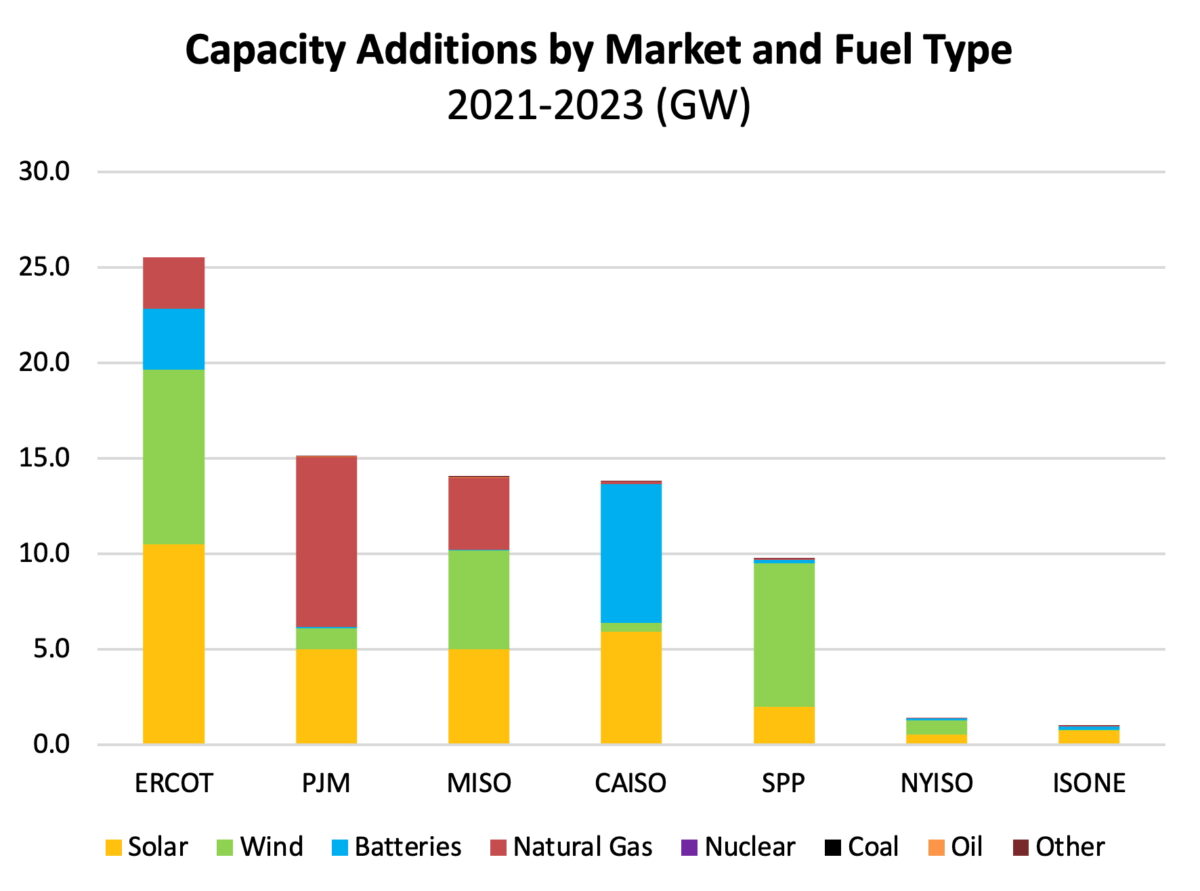Twenty-four industry participants support a more flexible interconnection process similar to the “connect and manage” approach used by Texas grid operator ERCOT, according to Duke University researcher Tyler Norris, who reviewed comments filed with the Federal Energy Regulatory Commission (FERC).
ERCOT’s approach is technically known as ERIS, for energy resource interconnection service. Using that approach has enabled ERCOT to interconnect far more solar, wind and storage capacity in the past three years than any other grid region, as shown in the featured image above.
In the ERCOT region, interconnection enables a generator to deliver energy to the grid most of the time, with occasional curtailment when transmission is congested. In areas where curtailment is the greatest, transmission expansion may be prioritized to reduce curtailment.
Norris found that 24 industry participants filed “in support of streamlined ERIS” nationwide, with “a handful” expressing opposition to a broad requirement for full ERCOT-style connect and manage, “but not ERIS modification.” Overall “it appears to be among the most broadly supported reform areas,” he said.
The utility Southern Company, one of the largest in the U.S., said in its comments that “ERIS is adequate for generator interconnections in Southern Companies’ region,” adding that “to increase the efficiency of the generator interconnection process, interconnection customers should be encouraged to use ERIS.”
Other industry participants that expressed to FERC their support for ERIS include renewables developers, renewables trade groups, groups representing electricity consumers, and environmental groups.
The comments were filed following a FERC interconnection workshop in September, which included a technical panel on ERIS.
Outside of ERCOT, renewables developers can choose to interconnect either through NRIS—that is, network resource interconnection service—or an approach to ERIS that is more restrictive than that used in ERCOT.
Norris has previously characterized NRIS as “invest and connect.” NRIS typically requires lengthy studies to determine the grid upgrades required for interconnection, and then additional time and expenditure to build the upgrades.
The ERIS option offered outside of ERCOT “is often treated similarly to NRIS in practice, or otherwise discouraged,” Norris said in his analysis. While ERCOT has the least restrictive ERIS treatment, he said, grid operators in California (CAISO) and New York (NYISO) have only moderately restrictive ERIS treatment.
In Norris’s own comments to FERC, he suggested FERC could consider promulgating, in a new regulation, the ERIS approach taken by NYISO and CAISO, “which assume that most if not all thermal power flow constraints can be managed in real time with redispatch, and therefore do not assign thermal network upgrade costs to ERIS generators.”
Other transmission owners use ERIS approaches that are more restrictive, Norris said, including the grid operators known as PJM, MISO and SPP, and the utility Duke Energy.
Norris last year analyzed how flexible interconnection could be used across the U.S., in a paper published by the Nicholas Institute for Energy, Environment and Sustainability at Duke University. More recently he co-authored two studies showing that an ERIS approach to interconnection can have a far lower cost than an NRIS approach, and can be completed at nearly twice the speed.
Norris presented his latest analysis in posts on the social media platforms LinkedIn and Bluesky.
This content is protected by copyright and may not be reused. If you want to cooperate with us and would like to reuse some of our content, please contact: editors@pv-magazine.com.








By submitting this form you agree to pv magazine using your data for the purposes of publishing your comment.
Your personal data will only be disclosed or otherwise transmitted to third parties for the purposes of spam filtering or if this is necessary for technical maintenance of the website. Any other transfer to third parties will not take place unless this is justified on the basis of applicable data protection regulations or if pv magazine is legally obliged to do so.
You may revoke this consent at any time with effect for the future, in which case your personal data will be deleted immediately. Otherwise, your data will be deleted if pv magazine has processed your request or the purpose of data storage is fulfilled.
Further information on data privacy can be found in our Data Protection Policy.